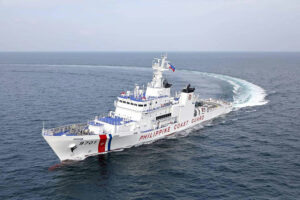
China renews call to remove PHL ship from Sabina
By John Victor D. Ordoñez, Reporter
THE CHINESE Foreign Ministry has renewed its call for the Philippines to remove an “illegally anchored” vessel at Sabina Shoal after a collision between their ships at the weekend.
“China asks the Philippines to immediately withdraw the vessel illegally anchored in the lagoon, and stop infringement activities and provocations at once,” Foreign Ministry spokesperson Mao Ning told a news briefing in Beijing late Monday, based on a transcript posted on the agency’s website.
China is ready to maintain dialogue through diplomatic means to sort out its sea dispute with the Philippines, she added.
Philippine Foreign Affairs spokesperson Ma. Teresita C. Daza did not immediately reply to a WhatsApp message seeking comment.
“These comments show the frustration of China in not being able to effectively, discretely, and hastily pursue its expansionist interests at Sabina Shoal,” Don McLain Gill, who teaches international relations at De La Salle University in Manila, said in a Facebook Messenger chat.
“There is a clear desire to intimidate the Philippines continuously and of course, to limit the ships that operate in that area given of course our limited resources in this regard,” he added.
A Philippine task force handling sea disputes with China on Saturday accused a Chinese vessel of “deliberately” ramming the Philippines’ largest coast guard vessel named BRP Teresa Magbanua thrice near Sabina Shoal.
The Chinese Coast Guard vessel caused significant damage to the ship and endangered the lives of its personnel, it said.
“The Philippines’ moves gravely infringe upon China’s sovereignty and violate international law and the Declaration on the Conduct of Parties in the South China Sea,” Ms. Mao said. “The Chinese side responded with necessary measures in accordance with the law, which was fully justified, lawful and beyond reproach.”
SWARMING
The Philippines said the number of Chinese vessels swarming within its exclusive economic zone (EEZ) had risen to more than 200, many of them deployed to Sabina Shoal.
There were 203 Chinese vessels within the Philippine EEZ from Aug. 27 to Sept. 2, up from 163 a week earlier, according to data released by the Philippine Navy.
Tuesday’s tally — the biggest since the Navy started publishing weekly tallies — was largely attributed to China’s deployments to Sabina Shoal, which has been the new hotspot in the South China Sea.
The number of Chinese vessels there rose to 71 during the Aug. 27-Sept. 2 period from 53 a week earlier.
The 71 Chinese ships recently deployed to Sabina included nine coast guard vessels, nine warships and 53 maritime militia ships, the Philippine Navy said.
The 97-meter-long BRP Teresa Magbanua has been near Sabina Shoal since mid-April, as Manila accused Beijing of dumping dead corals at the atoll to alter its elevation.
Sabina lies 140 kilometers off the Philippine island of Palawan and is part of the Spratly Islands.
The shoal has been a staging ground for Philippine resupply missions to Second Thomas Shoal, where Manila grounded a Navy vessel in 1999 to serve as an outpost for a handful of Filipino troops.
Ms. Mao said the Philippines has illegally anchored its vessel at Sabina Shoal, which China calls Xianbin Jiao, to “permanently occupy the area.”
“This is the root cause of the current escalatory situation at Xianbin Jiao,” the Chinese spokesperson said. “The measures China took at Xianbin Jiao are aimed at protecting its territorial sovereignty and maritime rights and interests.”
Philippine Foreign Affairs Secretary Enrique A. Manalo on Monday told reporters the Philippines had expressed its displeasure with China after Saturday’s collision — the second confrontation in days — adding that it did not help cool tensions in the South China Sea.
He said the Chinese side had, in response, “accused us, as usual, of doing this and that.”
The government of President Ferdinand R. Marcos, Jr. has filed 176 diplomatic protests against China, 43 of which were filed this year, Ms. Daza told reporters in a WhatsApp message late Monday.
The US, New Zealand and Australian embassies in Manila have expressed concern over the incident, urging China to follow international law.
In 2016, a Hague-based arbitration court upheld the Philippines’ rights to its exclusive economic zone within the waterway. It rejected China’s claim to most of the sea based on a 1940s nine-dash line map that Philippine Foreign Affairs Secretary Enrique A. Manalo has said “had no basis in law.”
Manila has been unable to enforce the ruling and has since filed hundreds of protests over what it calls encroachment and harassment by China’s coast guard and its vast fishing fleet.
Portions of the waterway, where $3 trillion worth of trade passes yearly, are believed to be rich in oil and natural gas deposits, as well as fish stocks.
The Philippines’ National Maritime Council last week said there’s a need to update the Philippines’ Mutual Defense Treaty (MDT) with the US, citing the changing geopolitical landscape.
There have been domestic calls to clarify provisions of the treaty after a June 17 standoff at Second Thomas Shoal, where Chinese forces allegedly threatened, using bladed weapons, Filipino troops delivering supplies to a Navy outpost there.
Filipino soldiers fought with bare hands, and one of them lost a thumb when his vessel was rammed by Chinese forces, according to the Philippine military.
Both countries have been trading blame over collisions near Sabina. Both Sabina and Second Thomas Shoal are within the Philippines’ exclusive economic zone. — with K.A.T. Atienza



